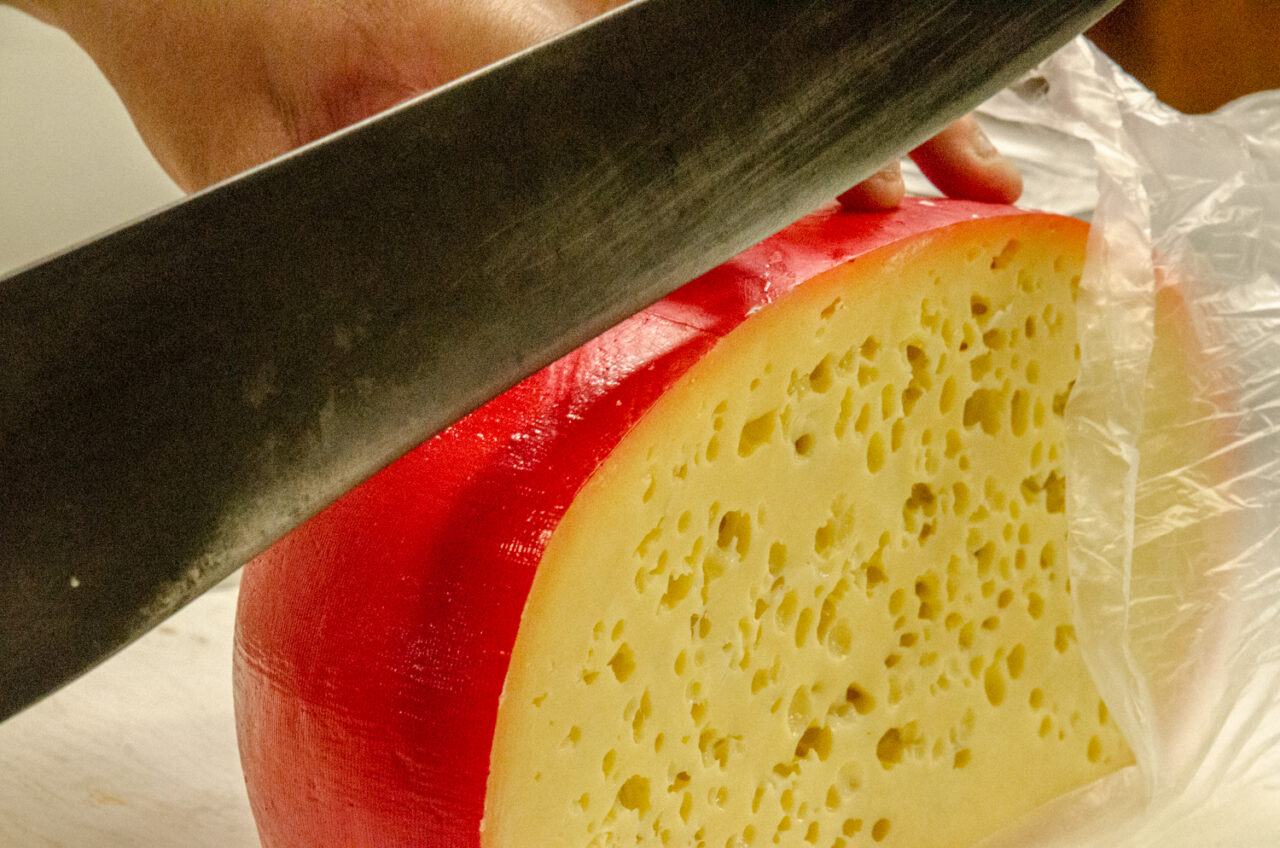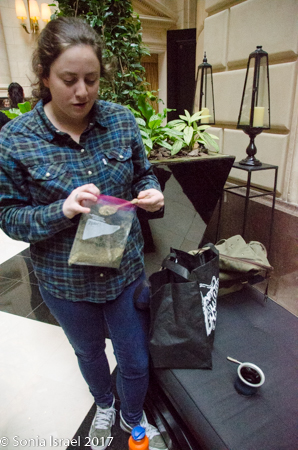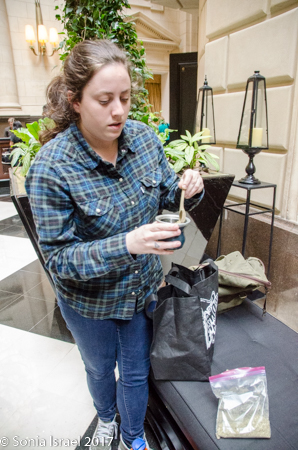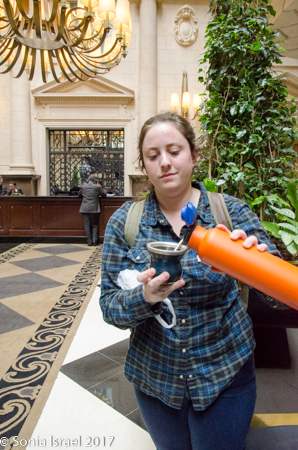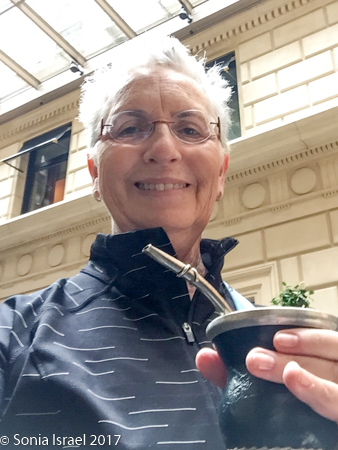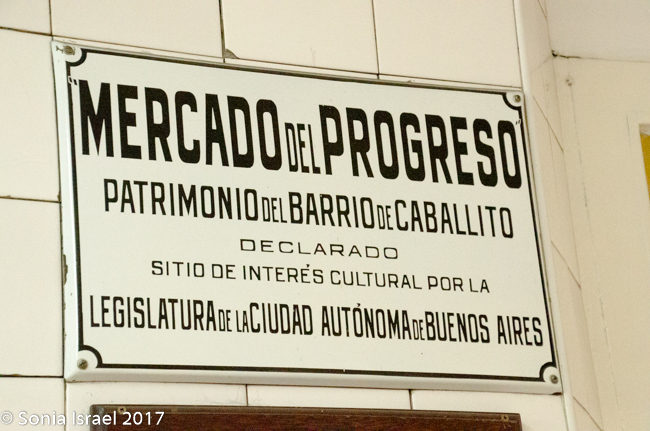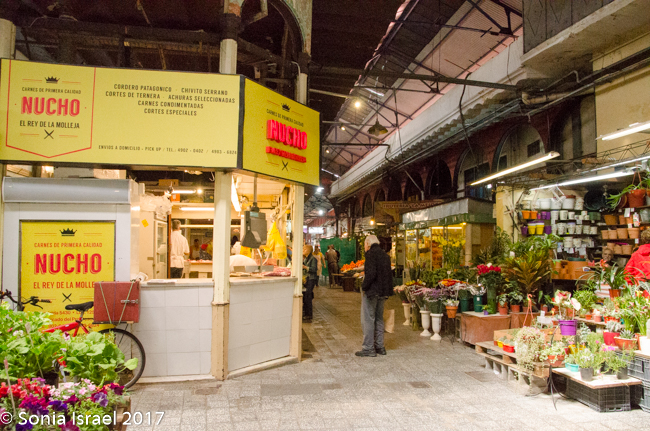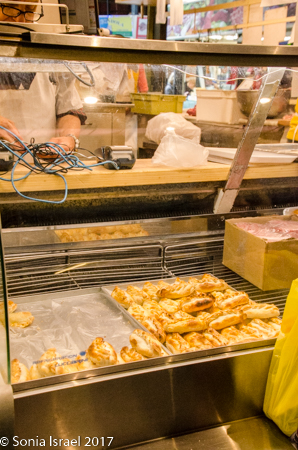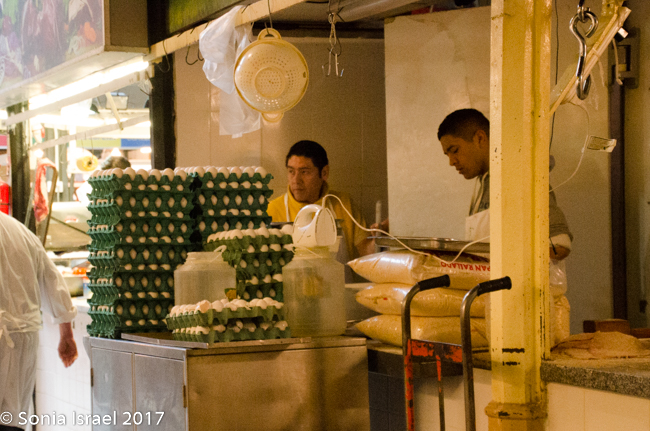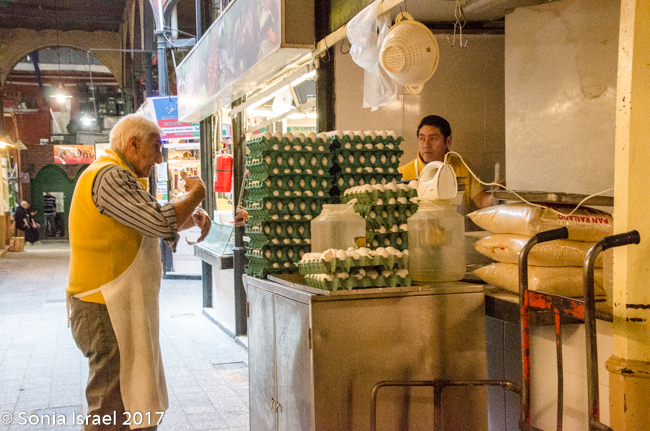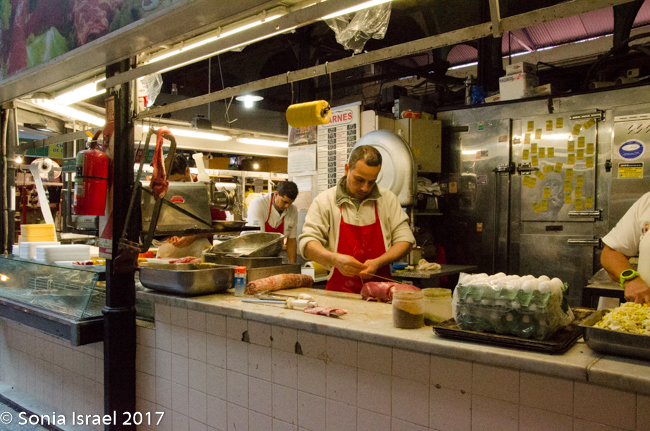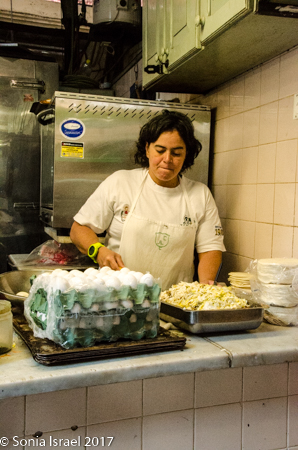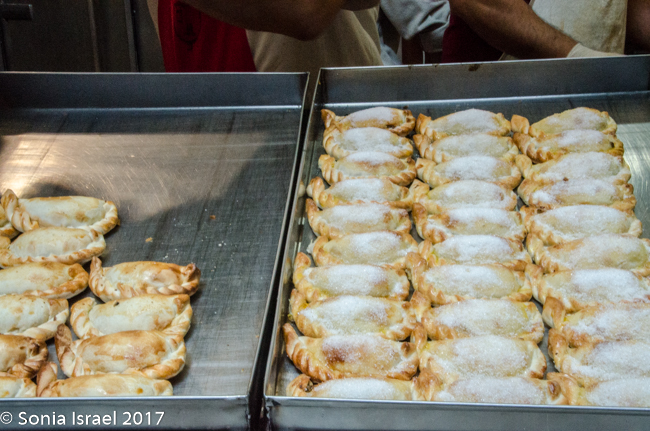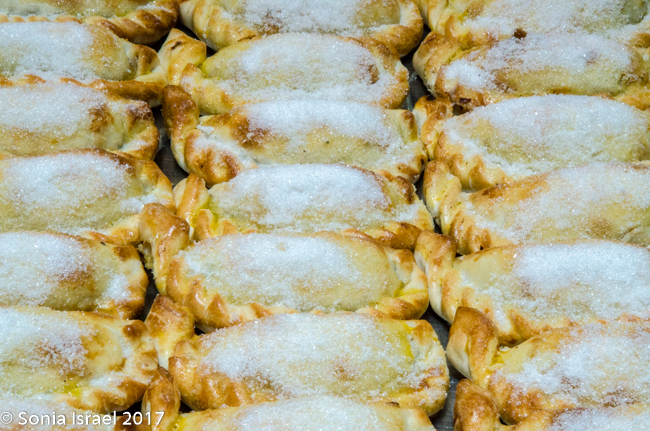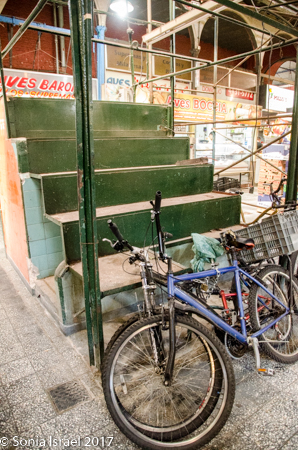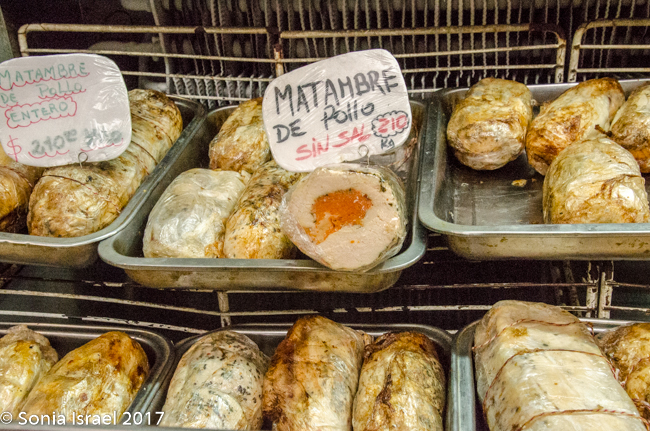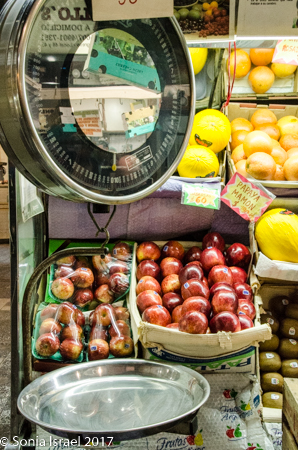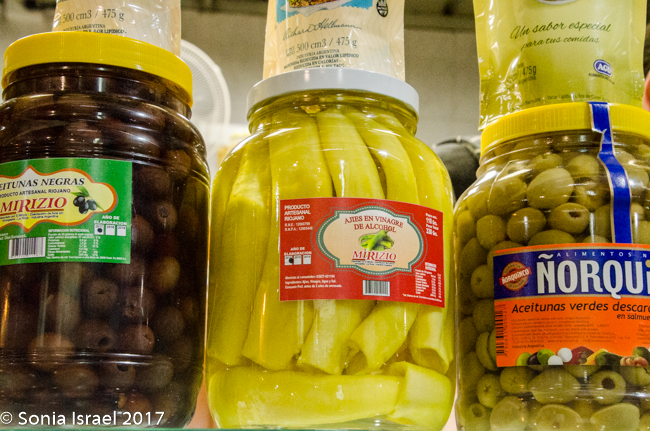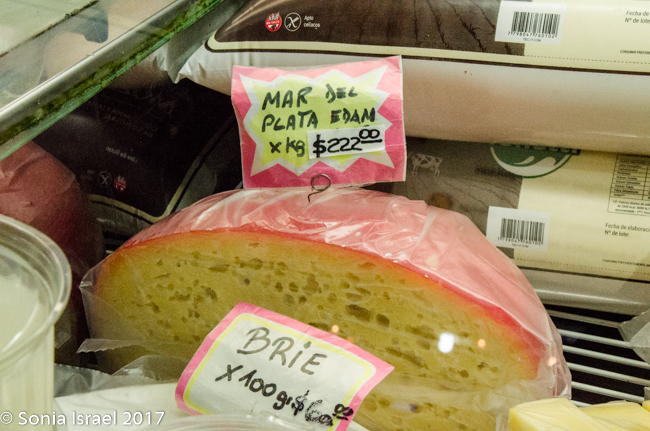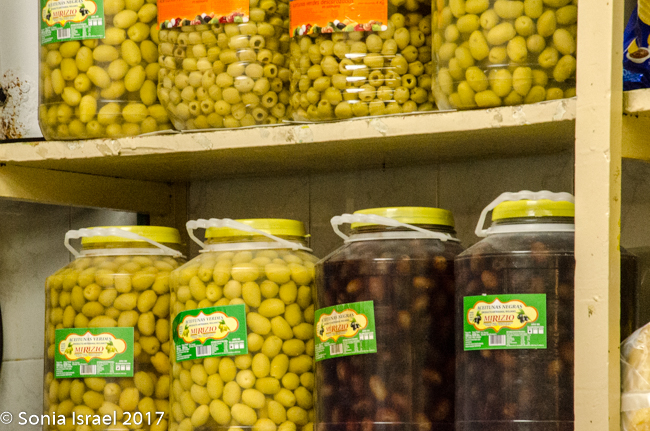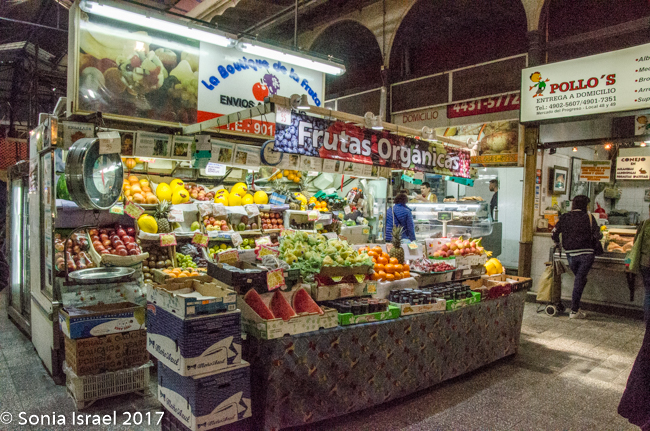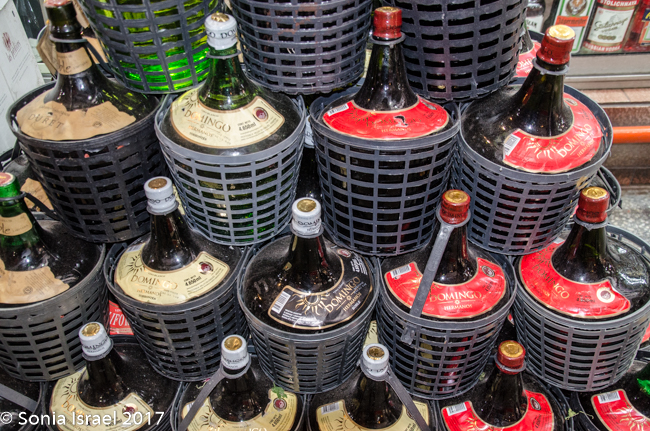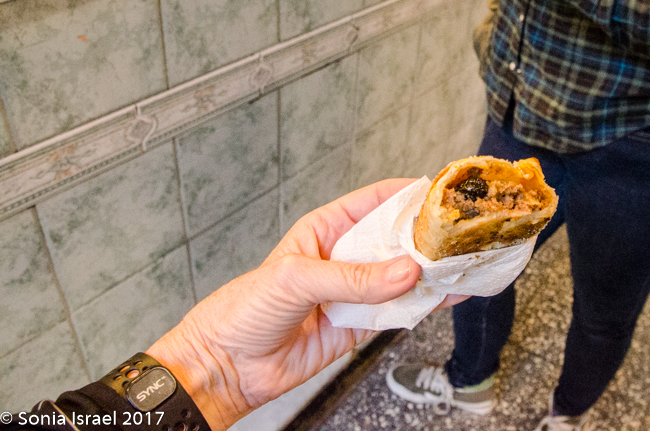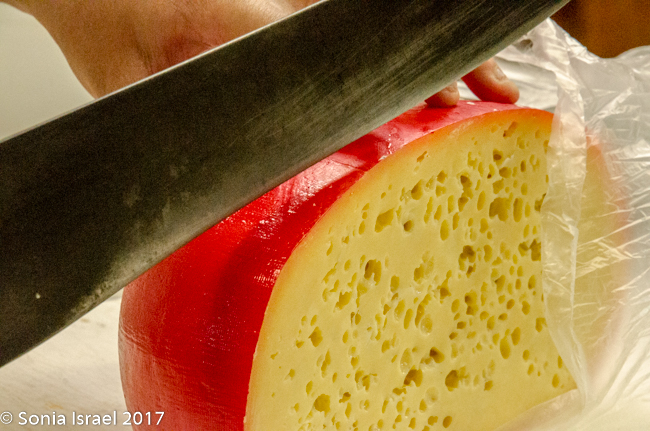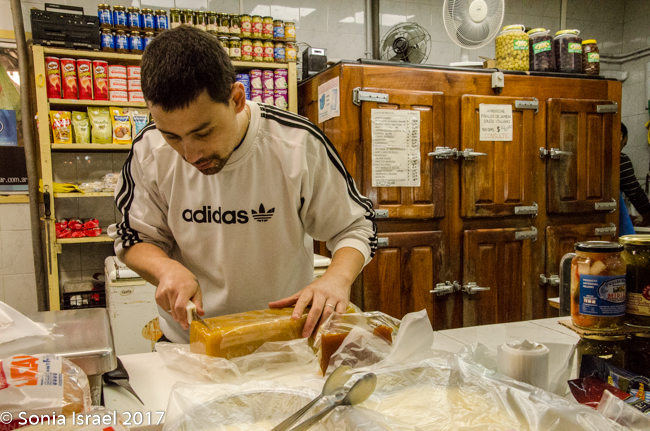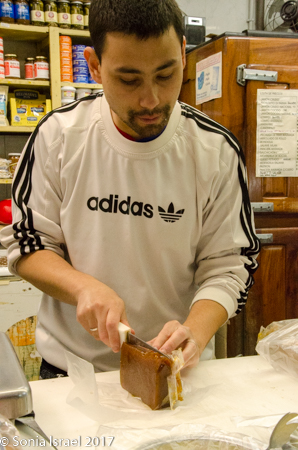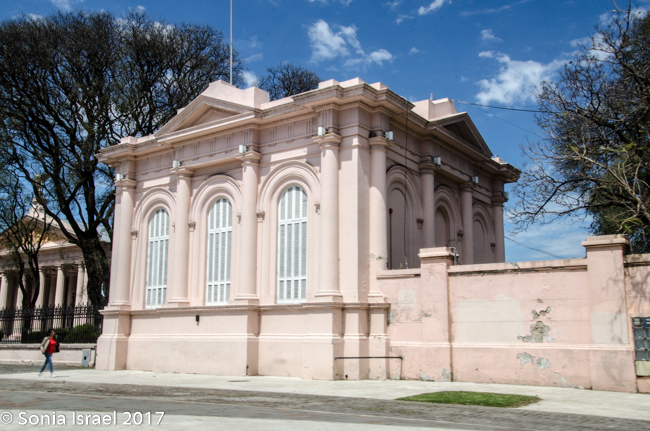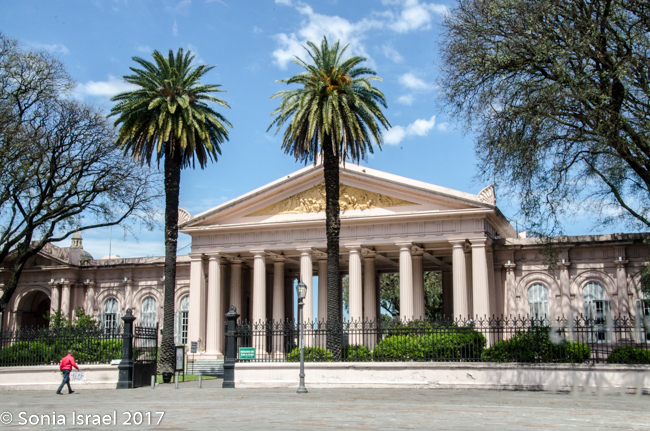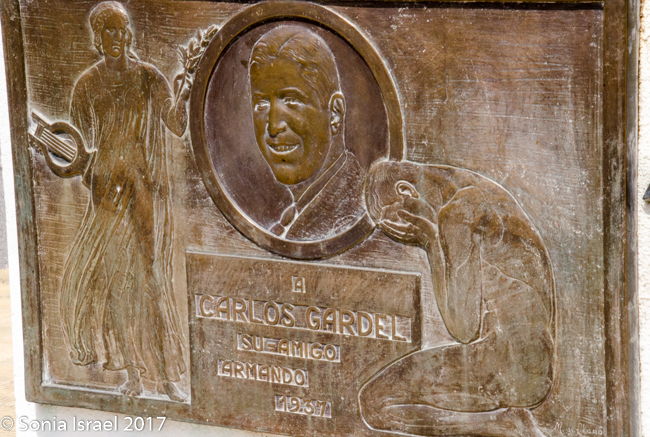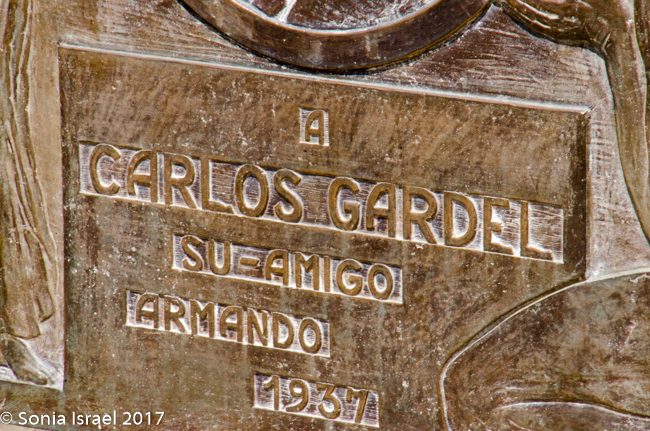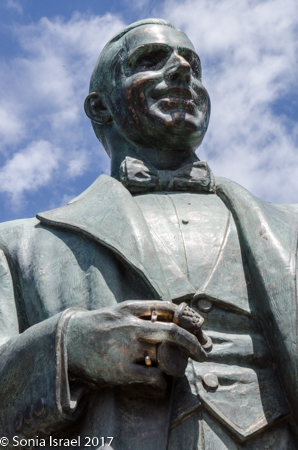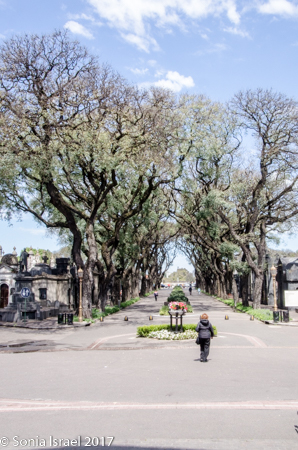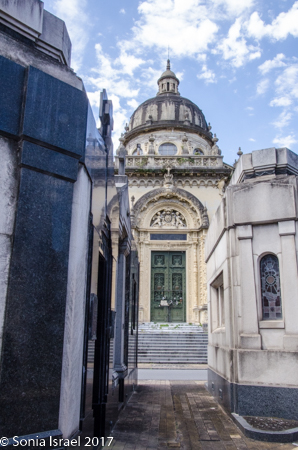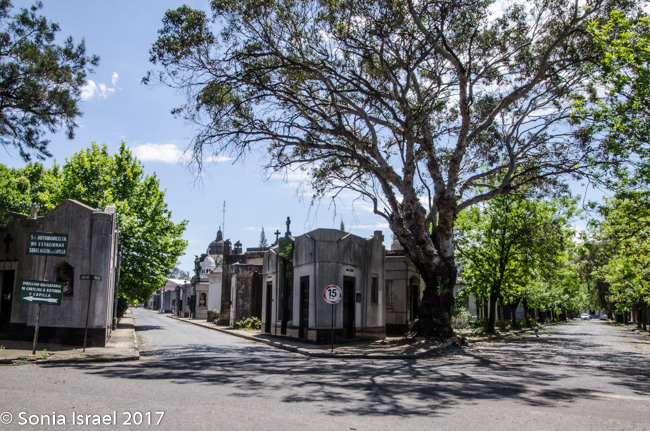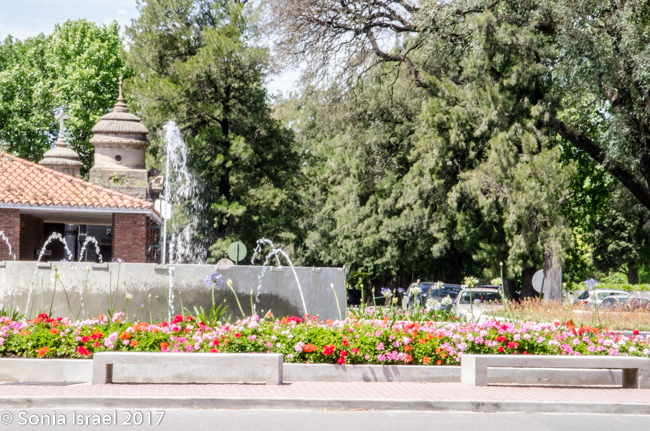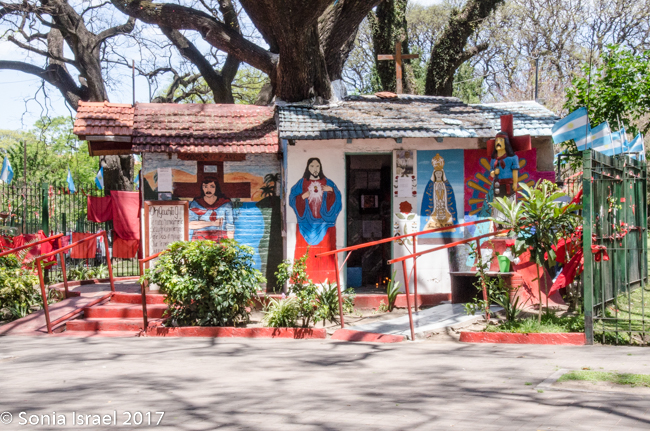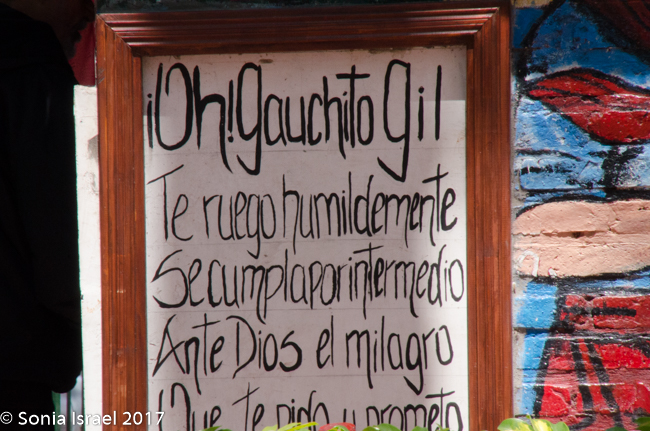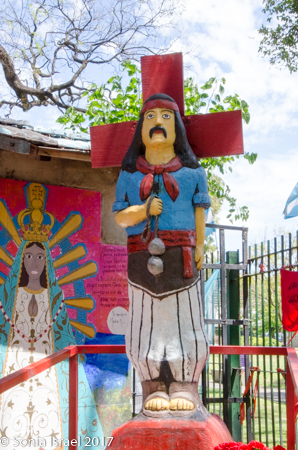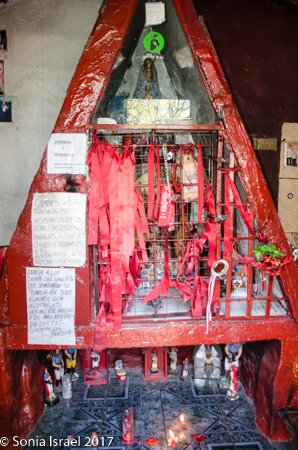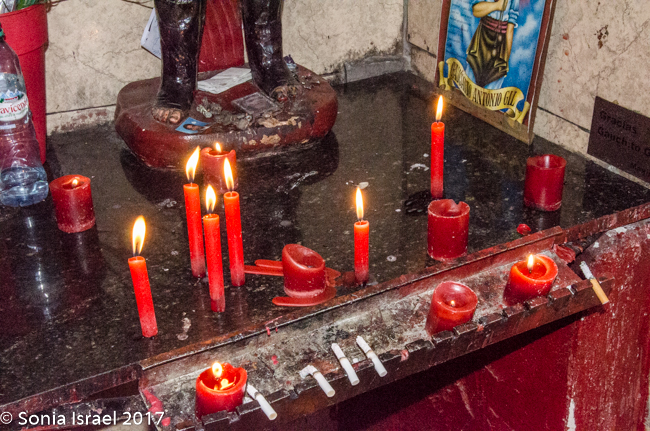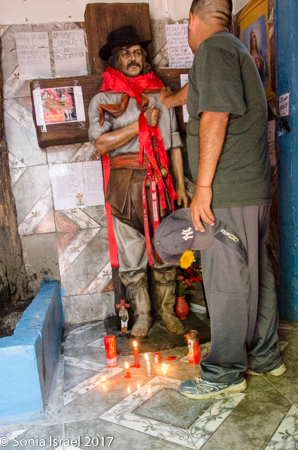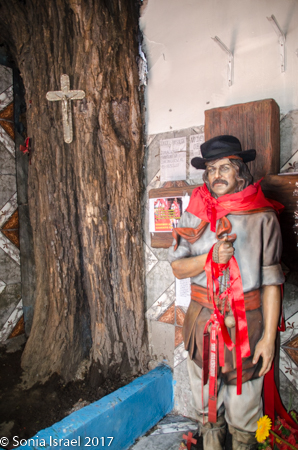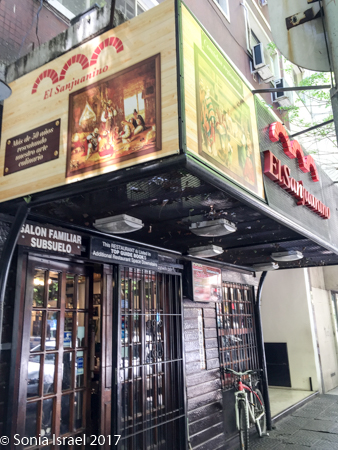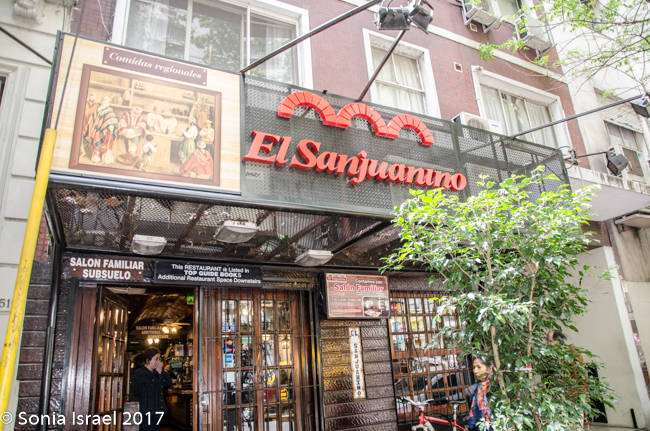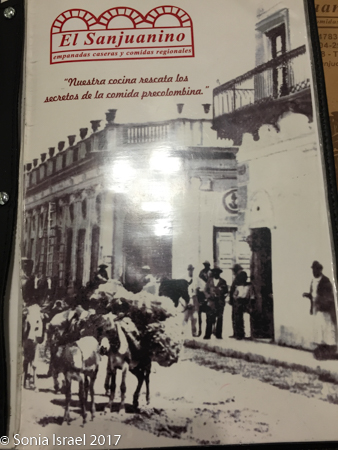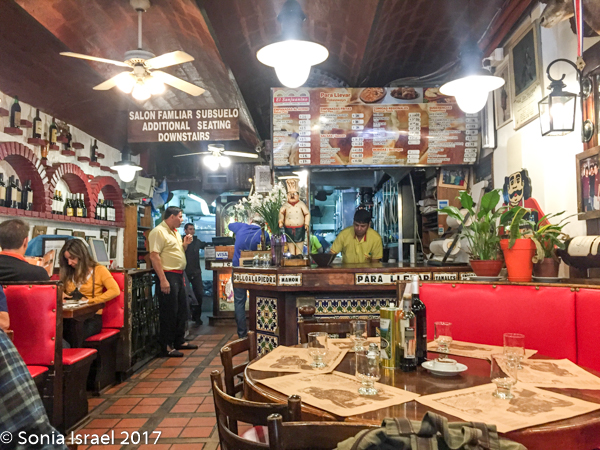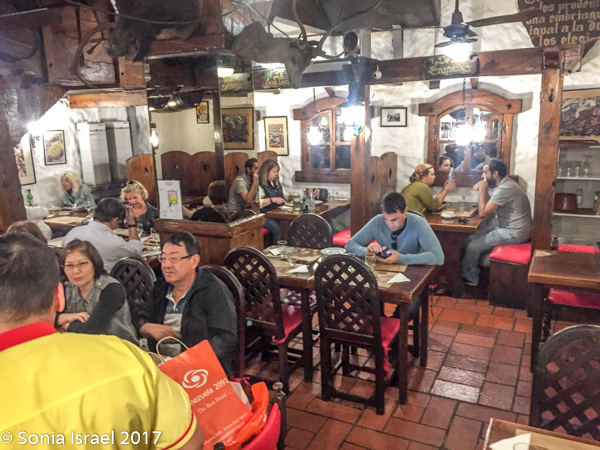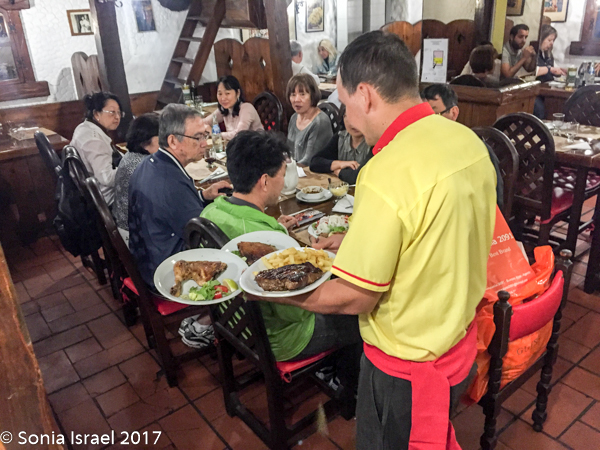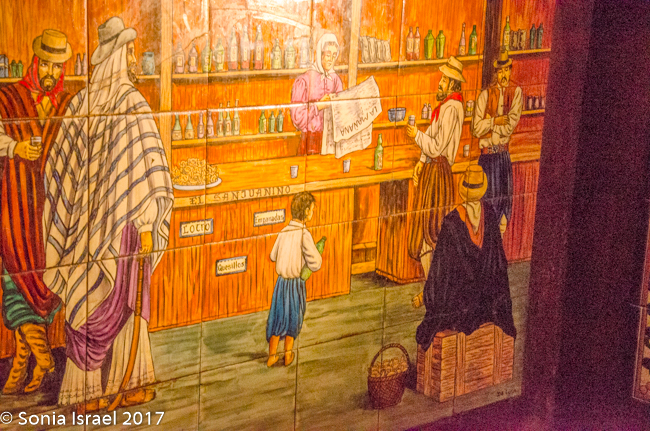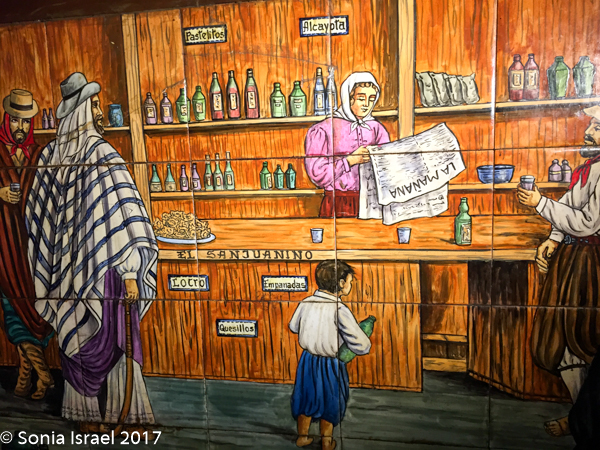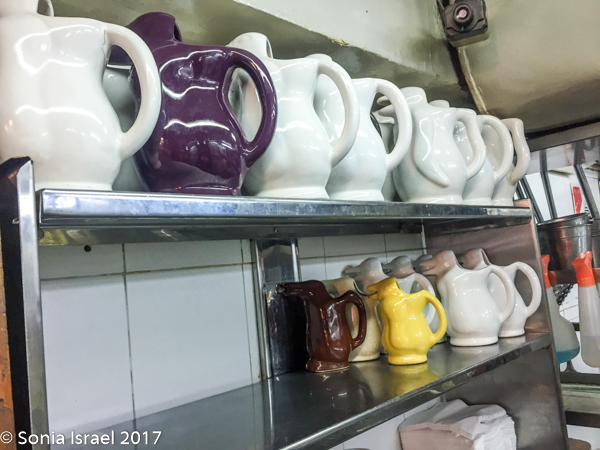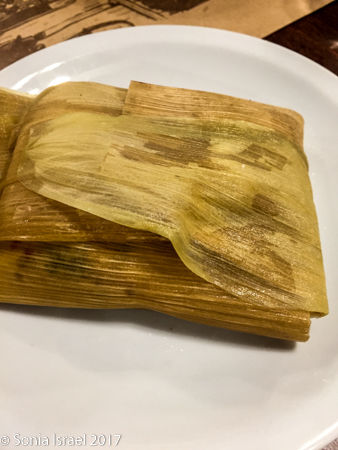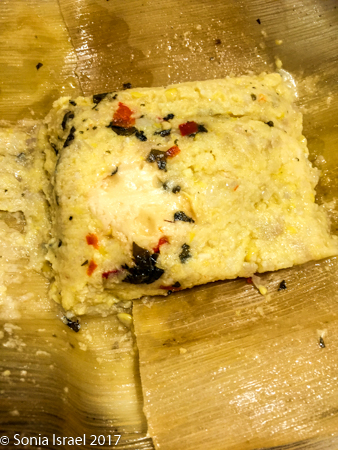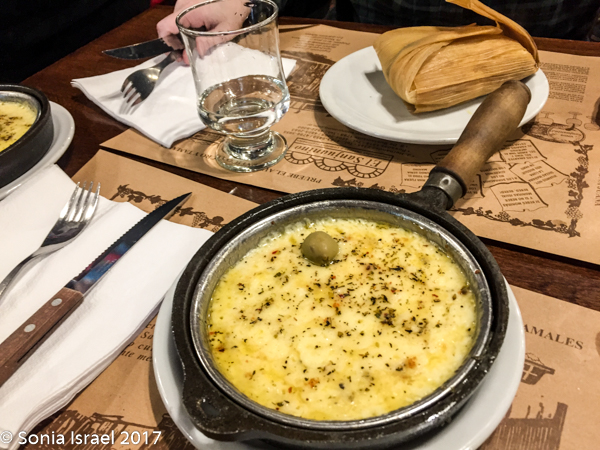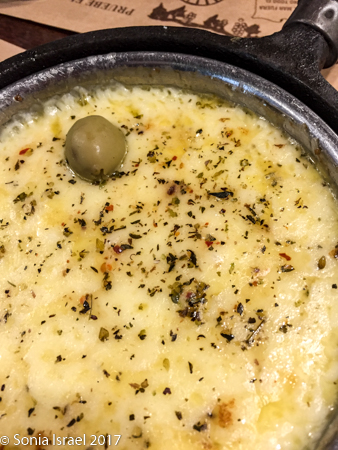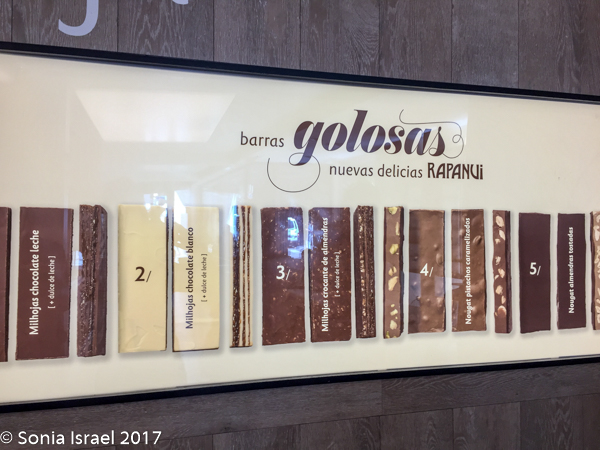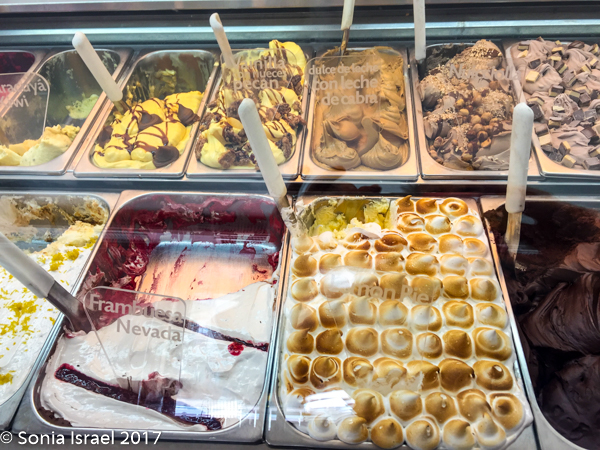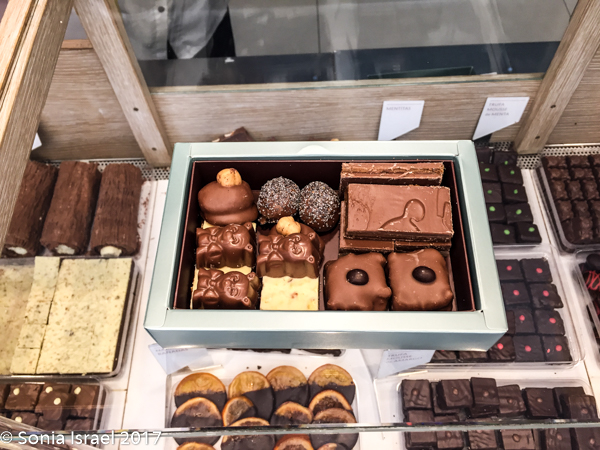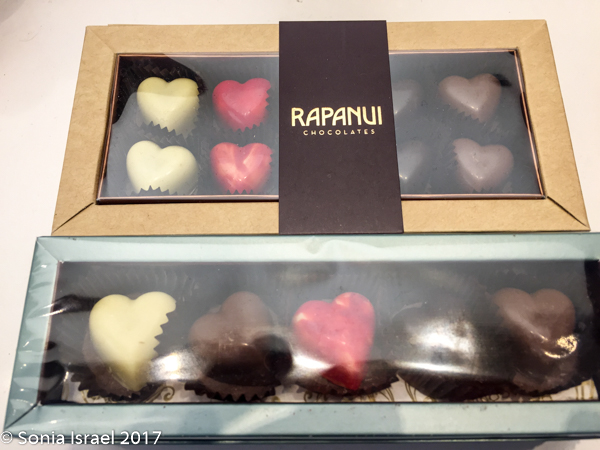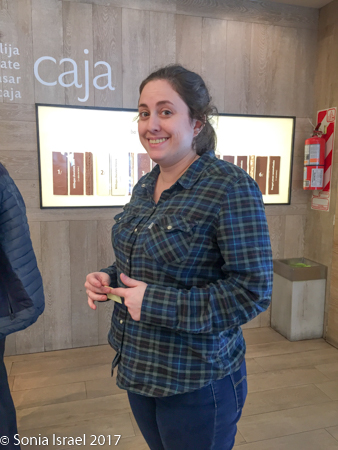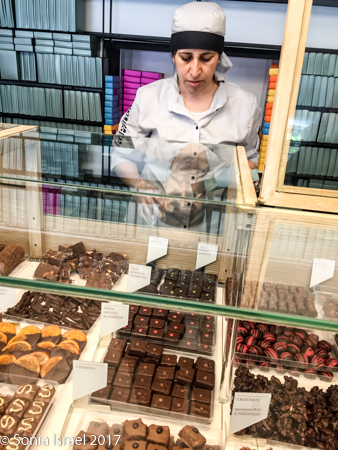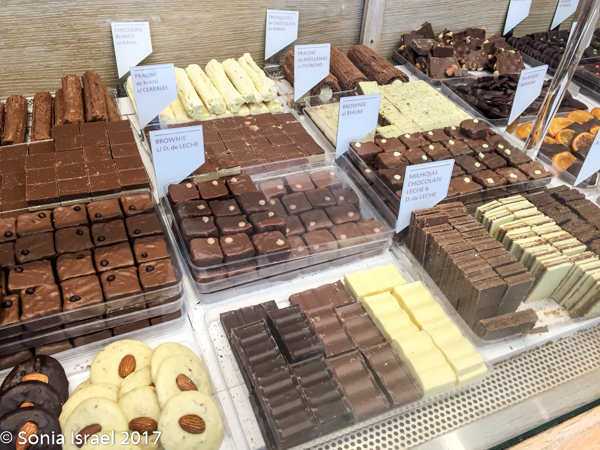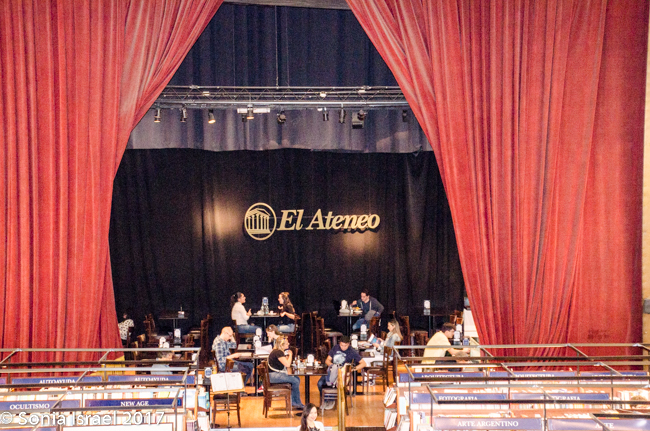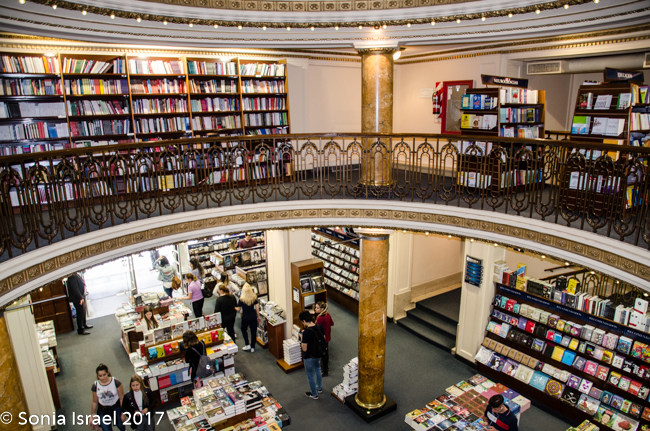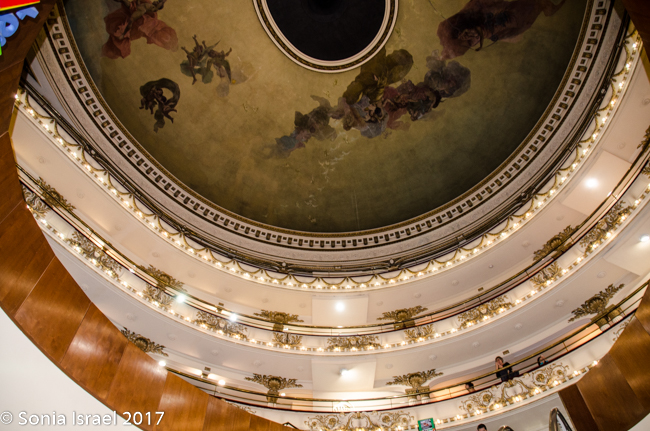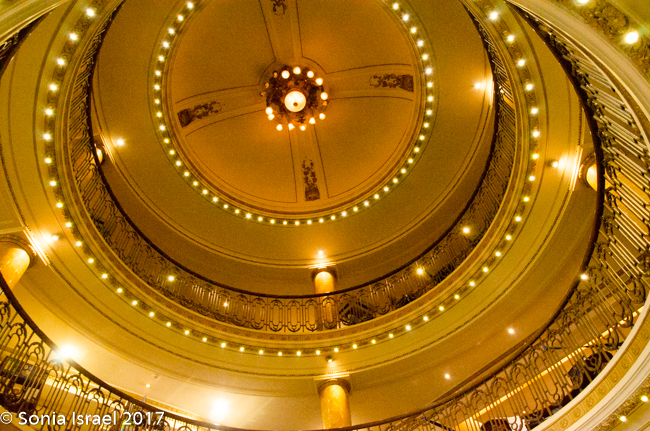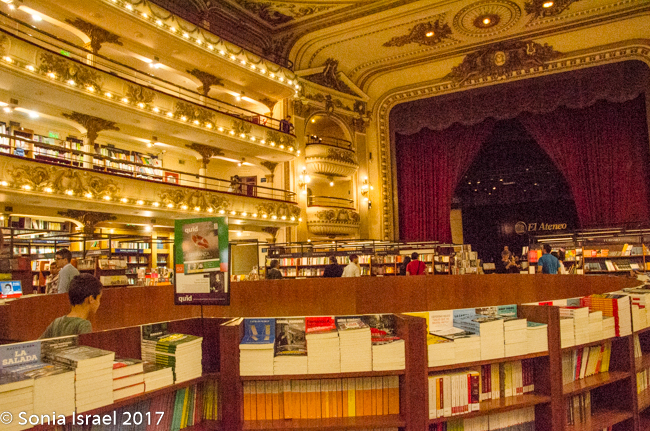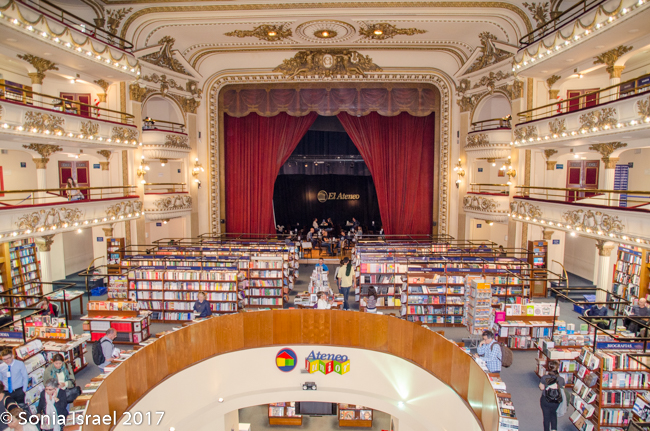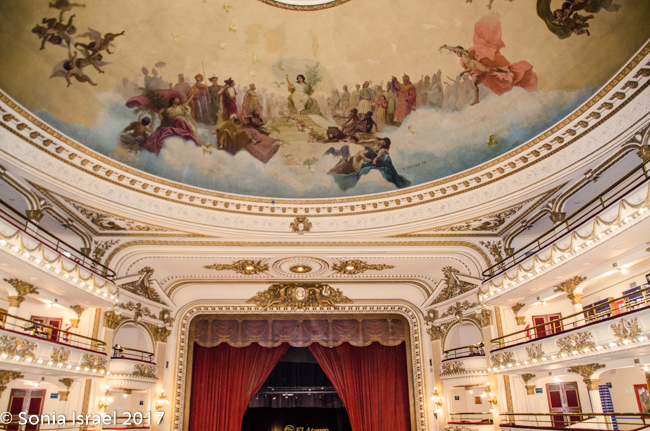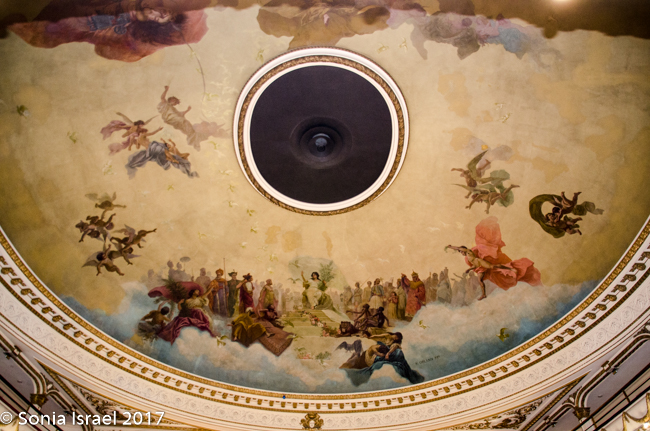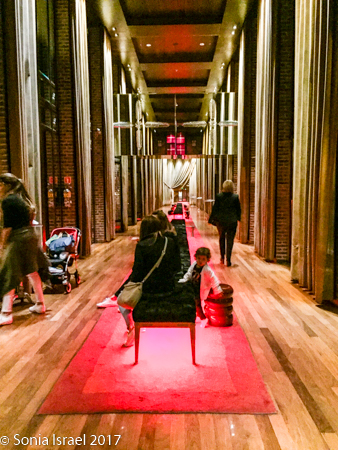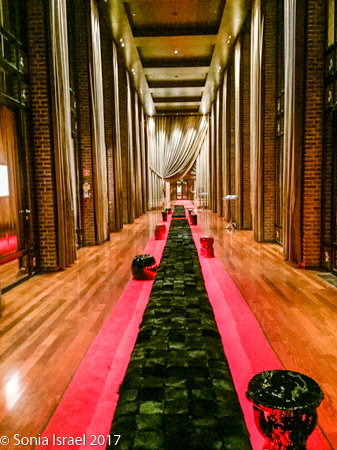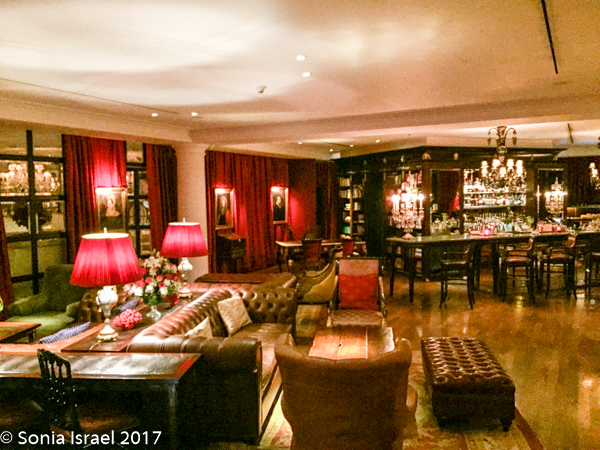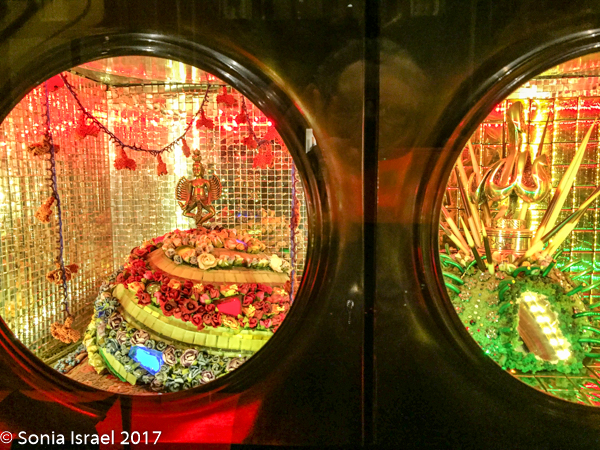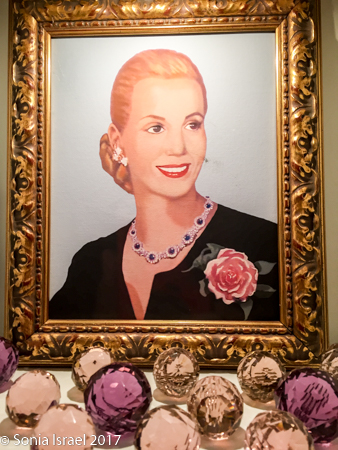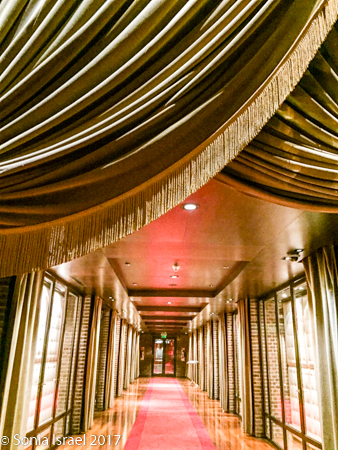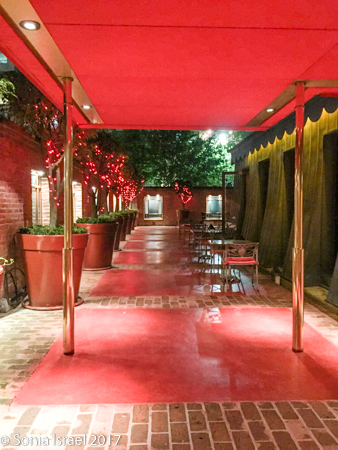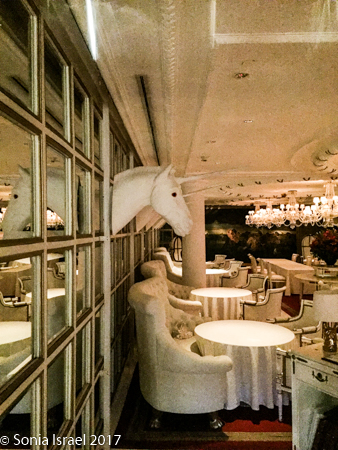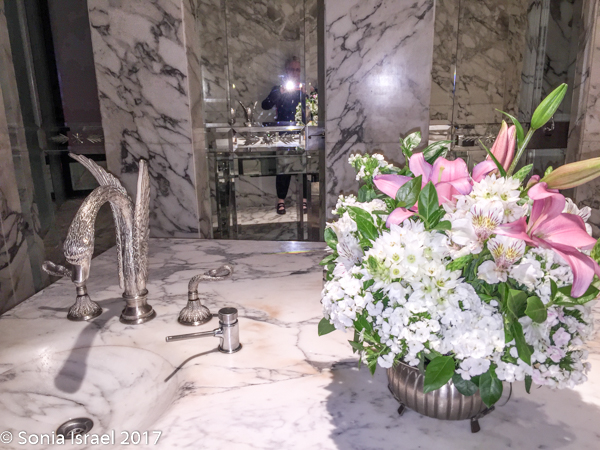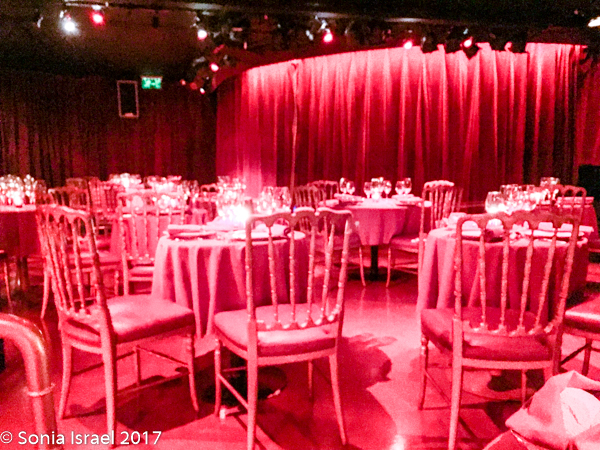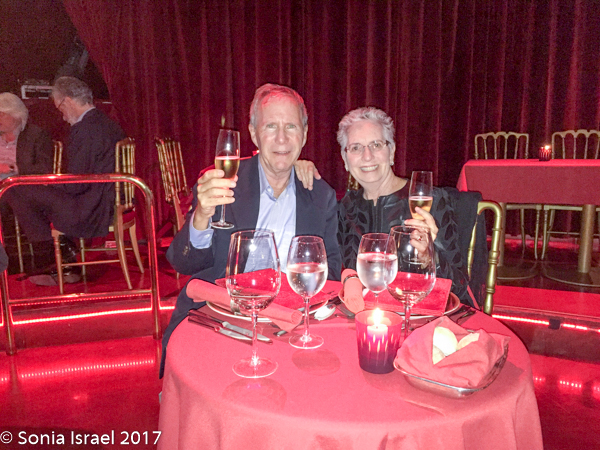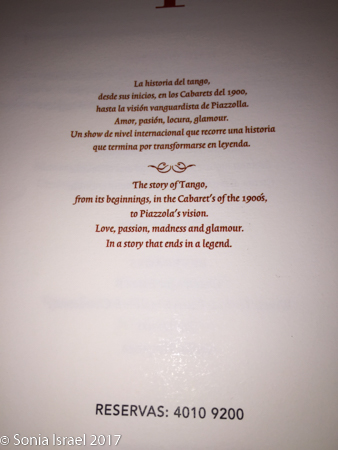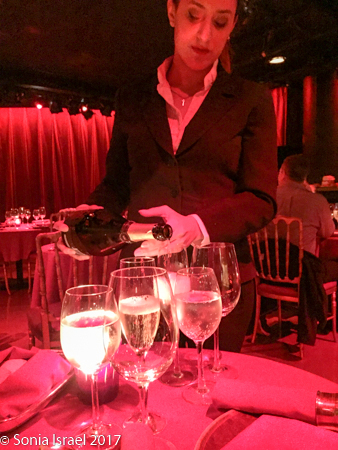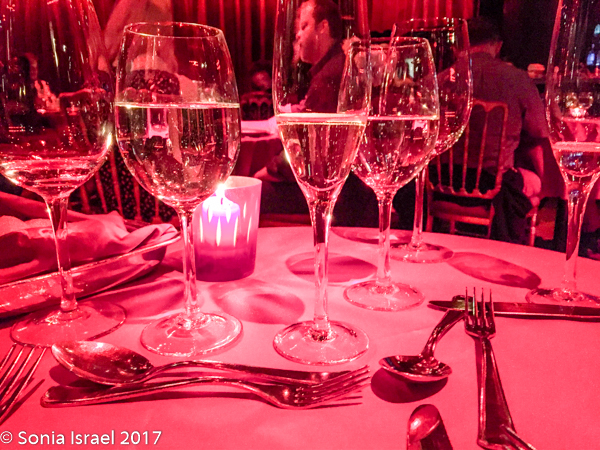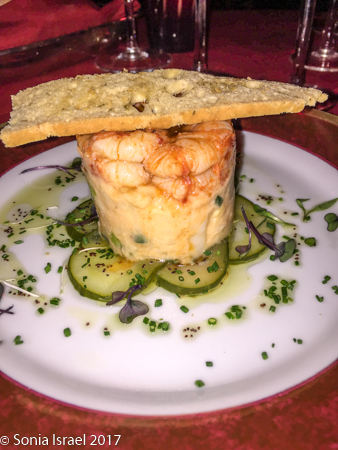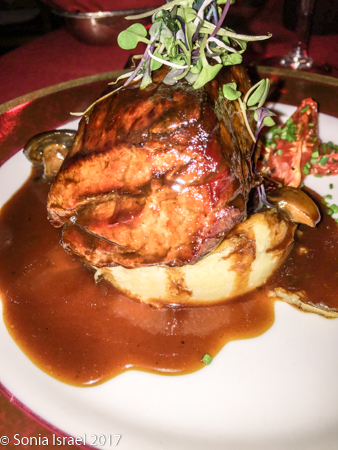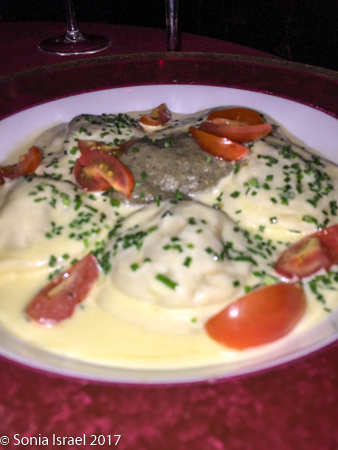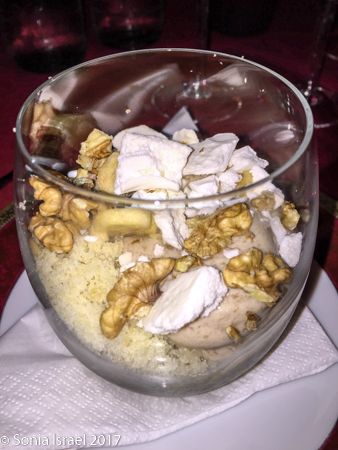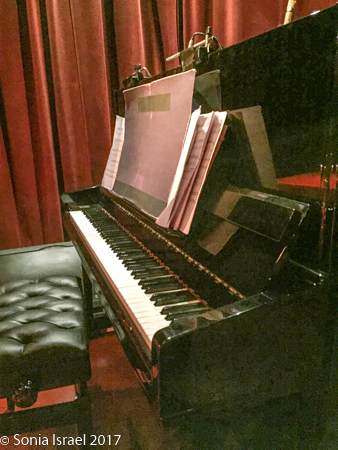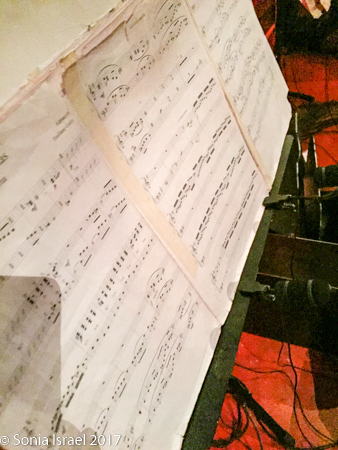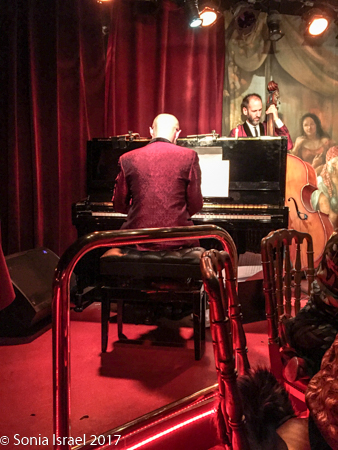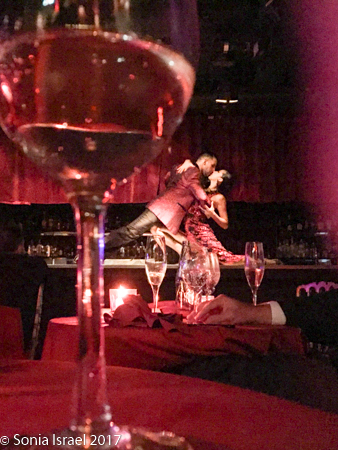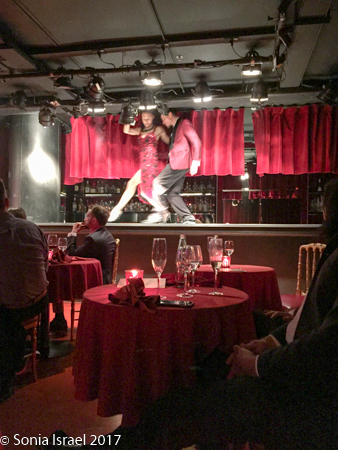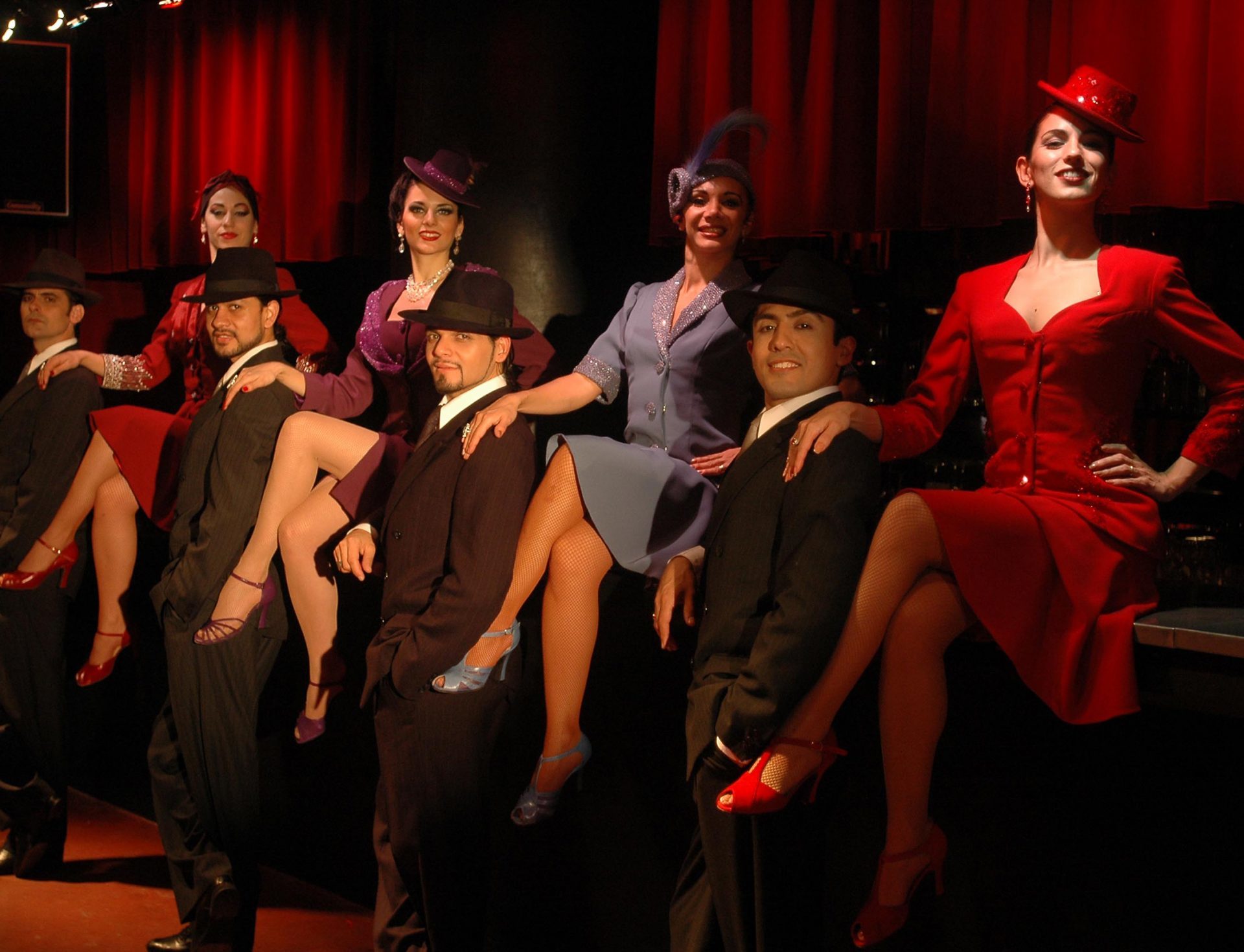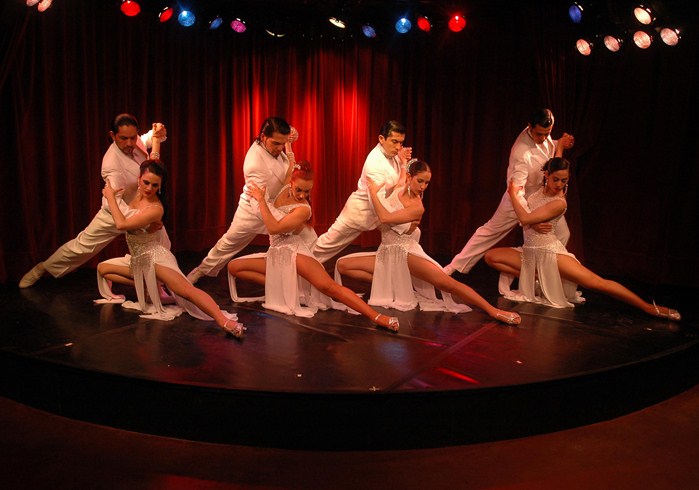Monday, October 23, 2017
Today was our food tour day. We met Mariana, our 25 year-old guide, in the lobby of our hotel. She works for craft beer company, working with the brew master when she is not acting as a guide. She had set up a mate brewing station as that would be our first lesion and taste.
Mate
Mate (pronounced MAH-tay) is in your face aggressive when you first drink it, that’s how strong it is. But in BA, everyone, EVERYONE drinks it all the time. They drink it on the street. They drink it in the subway. They drink it on the bus. They walk around everywhere carrying their thermos and other mate paraphernalia. And they share it with all their friends, so it is also a very social drink.
So Mariana showed us how to make it. First you need to know that mate is made from the yerba mate leaf which is not really a tea. Rather it comes from the rain forest holly plant (Ilex paraguariensis). Mariana had her thermos filled with hot water, her gourd (also called guampa or mate), and her bombilla (metallic straw that looks like a straw with a round filter at the bottom). She filled the gourd about 1/3-1/5 with loose yerba mate and tapped it to one side of the gourd, creating a small mountain with a little valley inside. She poured in a little bit of water (this should be cool water) into the valley, really just a splash to moisten it. The filter tip of the straw was then inserted into the valley. This was then tossed out as it would be very, very bitter. Only then was hot water (not boiling, around 1650175 degrees F) added and the mate is ready to drink. The host drinks first, always, then refills and passes it along. So Mariana drank first and then made some for us to taste. If I had to describe it, it would be an earthy, grassy taste. But that is something I would rather smell than drink. I think it is an acquired taste.
Once we had our fill of the mate (which did not take long; it takes much longer to make than to drink and I think that process and ritual is part of the fun for the locals), it was out to our car where Gustavo our driver was waiting for us.
Cabalitto
A word about this area itself, Cabalitto. Cabalitto is a barrio (which really just means a neighborhood). It was once the pampas area with low wavy grass and a shallow river, which means this is where the guachos were. Caballito mean “little horse” but it was not named for pony rides. Rather it is named after a horse-shaped weather vane that sat above a landmark local bar that the gauchos would frequent. The weather vane is now gone, but the name stuck.
Historically, Caballito was where wealthy Porteños would go on the weekends to kick back at their colonial-style mansions. Some of these mansions are still standing today. The University of BA is also here and so the streets and cafes are filled with university students.
Today Caballito is a classy, understated barrio with tree-lined avenues, cobblestone streets and some beautiful parks. For example, there is the Parque Rivadavia which features an every-day street market selling books and music (vinyl records, music scores etc). And of course, the Mercado del Progreso is here, and that’s what brought us to this part of town, the exact geographic center of the city.
Mercado del Progreso
Our first stop was the Mercado del Progreso (the Market of Progress). This is a very historical market which is locally owned. It was originally built by the Society of Pregress Caballito (Caballito is the name of the neighborhood), opening its doors in 1889. But back then it was privately owned by Don Santiago Cangallo who earned a place in the locals hearts as he would give free meat to the poor living in the Caballito neighborhood. After 125 years, it is considered a cultural heritage site. Local chefs and foodies in general come here to shop for their fruit, vegetables, eggs, cheese, meat, fish, bread, empanadas, etc etc. Although now it is owned by the different stall tenants who formed a corporation, many of the stalls are passed down through the generations and to this day 60 of the stalls are owned by grandchildren or great grandchildren of the original pioneers.
Marianna walked us around, introducing us to the vendors, explaining what we were looking at. We tasted empanadas. We tasted batata (sweet potato). We tasted some dulce de membrillo (quince paste) which is eaten with cheese for dessert. So of course, we tasted different cheeses to go along with our membrillo. The vendor cutting the membrillo, which was in a large bar, and cutting the cheeses, worked very gently like he was handling the most delicate flower. People take great pride in the work here. And of course, we tasted some dulce de leche, which Mariana bought for us to take home.
Cementerio de la Chacarita
We were getting rather full from all the tastes at the market, so Mariana took us to visit the La Chacarita Cemetery where she wanted to tell us all sorts of fables.
Unlike Recoleta, the La Chacarita cemetery, located in the Chacarita part of BA (which gave birth to one of the great football teams), is the national and the largest cemetery in Argentina. It all goes back to the yellow fever epidemic of 1871. La Recoleta refused to allow victims of the epidemic to be buried there. The other cemeteries were strained beyond capacity. So the students of the College of San Carlos set aside 12 acres for this new cemetery.
The entrance to the park has a grand depiction of the final judgement with a reproduction of Michelangelo’s Pietà. Chacarita Cemetery has designated areas for members of the Argentine artistic community, including writers, prominent composers and actors. Former President Juan Peron was originally buried here until his remains were relocated.
Chacarita is more characteristic of many religions. The people here were buried with they things they enjoyed in life. There are lots of local celebrities 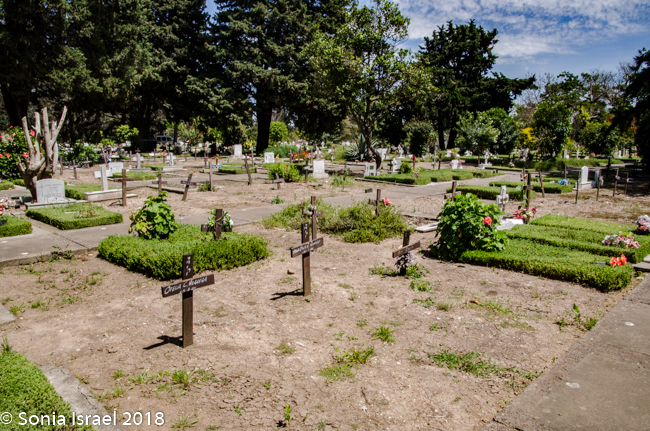 buried here including actors, authors, politicians, notable British immigrants and even a Nazi naval captain. Most of them are buried in their own section (Rincon). But there is also a section for the poor, giving them a final resting place.
buried here including actors, authors, politicians, notable British immigrants and even a Nazi naval captain. Most of them are buried in their own section (Rincon). But there is also a section for the poor, giving them a final resting place.
There are also lots of superstitions around the different graves. Mariana told us the story of Sheelda (not sure spelling is correct; Mariana, if you are reading this, please send me a note with the corrections about this wonderful story) who is now an unofficial saint. She was married but unhappy. So she got divorced, followed her dream and became a singer. But she died young and now it is believed that if you pray to her, your dreams will also come true.
Mariana told us about lots of other superstitions and wonderful stories about this cemetery, but alas, I did not write them down.
Carlos Gardel
There was one more grave however, whose story I do remember. One of the people most responsible for making tango famous was the tango singer Carlos Gardel, also known as The King of Tango. He was one of the first to put words to tango music and composed his own romantic tango songs. He died tragically in a plane crash when he was only 45 years old. It is said that his baritone voice and the dramatic phrasing of his lyrics made miniature masterpieces of his hundreds of three-minute tango recordings. His mausoleum, an elaborate monument, is one of the most visited tombs in the cemetery. The mausoleum is topped by a statue of the the smiling Gardel, dressed in a suit with one hand in his pocket and the other bent at the waist. This has led to many of his fans placing a lit cigarette in his hand. Fans also leave flowers and other mementos. Right near Gardel’s grave is a statue of tango composer Osvaldo Pugliese tapping at the piano and of legendary bandoneon player Anibal Troilo iwith his beloved instrument (a bandoneon is a concertina particularly popular in Argentina and used in tango music).
We continued walking around the cemetery. We saw a funeral in progress. What surprised me about this was that the people there were dressed in shorts and t-shirts and not at all dressed up in the sophisticated way one expects at funerals and especially in BA.
But we were not done with fables yet. Next stop, the shrine for Gauchito Gil.
Gauchito Gil: Argentina’s Cowboy Saint
We drove out of the cemetery a few blocks over to the main tree-lined street, where there was suddenly a red shrine. Mariana had us get out of the car and walk over to it as she told us this story: Antonio Mamerto Gil Nunez, better known at Gauchito Gil, is the colorful figure that is revered by many in BA, actually in all of Argentina, as a mystical symbol of bravery. He has been described as a combination of Robin Hood, patriotic soldier and protective Saint. And although considered a saint with a shrine devoted to him, he is not sanctioned by the Catholic Church. The story tells us that Gauchito Gil lived, loved and fought in provincial Argentina back in the nineteenth century before he was strung up and executed for desertion in 1878,
And here is the rest of the story:
There was a wealthy widow rancher from the town of Pay Ubre, Estrella Diaz de Miraflores who had a love affair with a gaucho Antonio Gil. The gauchos were known for being fierce ranch workers, who would drift from ranch to ranch in the Pampas, looking for work. The idea of an affair between a rich widow and a gaucho was quite the sordid story, especially for the local police commissioner, as he himself was in love with the widow. And so this police commissioner joined forces with Estrella’s brothers and they framed Gil for robbery.
Gil of course was used to rambling and moving about so he took off because the police could get him. He joined the army and fought for the Triple Alliance forces against the Paraguayans. In this way he became a patriotic and inspirational fighter.
After the war he returned to Pay Ubre, but this time as a hero. But the times were hard. The tyrant Rosas had been ousted which resulted in two dueling factions, the federalist Reds and the liberal Blues. Civil war broke out between the two. And as a war hero, Gil was recruited into the Blues. Unfortunately, Gil’s gaucho principles went against all the Blues stood for and, he was tired of war, especially a war where countrymen fought each other, brother against brother.
And so Gil fled the army. With his companions, he took to robbery, living off the land by poaching cows. The local peasants thought of him as an honorable thief, like a Robin Hood, taking form the rich and giving to the poor. And so they protected and hid Gil and his men, thugs helping them avoid being caught. But his luck did not hold out and eventually he was caught. The was taken to Goya to stand trial.
And here is where he turns from a Robin Hood to a saint.
The policeman who was bringing Gil to Goya was corrupt and got tired of the long journey. He decided to execute Gil right there and made up a story of an attempted escape. Gil was hung by his feet from a tree and the policeman was getting ready to cut his throat.
But Gil was clever. He begged the policeman to wait, saying that an official pardon was on the way. The policeman didn’t believe him and continued getting ready to kill Gil. But little did he know that in fact, the judge in Goya really had pardoned Gil. But the message had not yet arrived. Gill tried again to save himself. This time he told the policeman that he should rush home because his son had suddenly become sick. Still the policeman did not believe him. And so, right before his throat was slashed, Gil told him that the only way to save his son would be if his own name, Gauchito Gil, was invoked in prayer. And then his life was ended.
When the policeman got home, he found that his son was indeed very sick. And so he prayed to the now deceased gaucho. And wouldn’t you know it, his son got better. So the policeman returned to Gil’s burial site and planted a wooden cross over it. As more and more people heard this story, more and more came to visit Gil’s grave. And this was the start of the first Gauchito Gil shrine.
But the story is not over yet. The rick owner of the land where Gil was buried got tired of all the pilgrams running all over his land. So the grave was moved to a cemetery in a nearby town, Mercedes. The landowner fell sick and began himself to pray to Gil for forgiveness. And he got better. And thus began the pagan-style cult that to this day attracts devotees of Gil from all over Argentina. And while not an “official” saint, Gauchito Gil is one of the more popular and famous ones.
So here we were, on this tree-lined street in an otherwise bleak neighborhood, at this cluster of bright red which clearly marks the location of the Gauchito Gil shrine. Old women come to place flowers in front of the glass-encased statuette of Gil. There was a large red cross with a figure of Gil, with long hair, a red bandana, blue shirt and white striped gaucho pants. Inside was another statue in a red case and there were red candles and cigarettes burning all around. One man was there praying for something he needed or wanted. That’s what people do. They come here to pray to Gauchito Gil.
Antonio Gil likely was not a real person but so many believe in his power that he has become quite the folk saint.
Lunch at El Sanjuanino
Now it was time to taste and eat again. This time we went to a restaurant, El Sanjuanino. Turns out it is right next door to Fervor, where we had just had dinner a few nights before. Their motto is “Eating is a biological act, Eating in El Sanjuanino is a cultural act.” They are known for the empanadas and for their wine. It was a bit early for us to have wine (although many Argentinians would disagree). The restaurant had tables set closely together on the main level, and more tables down below. There was a wonderful tile mural of what a store in the olden days would have looked like. And they had penguin pitchers (pinguinos), whole shelves of them. Why penguin pitchers? This is the traditional way wine is served in Argentina. They used to be made of aluminum and started being used in the 1940’s, filled with Mendoza wine cut with water or soda. Today they porcelain and come in many colors, sometimes with ties or bowties. But no matter how much I begged to buy one, they refused me.
Mariana ordered for us, Grilled provolone, called provoleta. This is an Argentinian version of provolone cheese, cut into thick slices and submerged in hot whey while being spun, thus softening it so it can be kneaded and formed into the desired shape. It was served in the skillet and topped with olives. Our second dish was Humita, a corn dough wrapped and cooked in the leaves of an ear of corn.
There was a great dessert menu, but that was not to be as Mariana had other ideas for dessert. We were not done yet.
Rapanui
Rapanui? What, are we in Easter Island? No. Rapanui is this amazing gelato and chocolate shop in Buenos Aires. This wonderful slice of heaven on earth was begun by Aldo Fenoglio from Italy and perfected his family tradition of making the best handmade chocolate. The tradition was transmitted from generation to generation until they emigrated to BA and brought their chocolates with them. But I still don’t know why it was called Rapanui. What I do know is that the gelato (dulce de lecha, or course) and the chocolates were both out of this world. Andy and I each got a cup of gelato and Mariana bought us a gift box of chocolates, which we got to hand pick. It was a hard choice but we tried to get lots of different kinds. And boy did we enjoy them over the next two days, trying very hard not to gobble them all down at once.
El Ateneo Bookstore
We said good-bye to Mariana at that point and she headed off back to her life and we headed off, walking, to find the El Ateneo Bookstore. We had a map. It wasn’t such a long walk, but somehow we couldn’t find it. So we stopped in a shop and the shopkeeper came out onto the street with us to point us in the right direction. Turns out we were pretty close.
Why were we going to a bookstore? Well, the El Ateneo Bookstore is a 100-year old theater that was converted into a bookstore, which makes it one of the more (if not most) beautiful bookstores in the world. The ceiling is domed with beautiful murals. The balcony’s are still there so you can browse books while looking down at the stage, which is now a café. It was fun, fun, fun to walk around and watch the people, half of whom were actually buying books (yes, real books) and the other half, like us, were just mesmerized by the building itself.
Tango, tango, tango
From the bookstore we walked back to our hotel to get ready for our evening adventures. We were finally going to see some real, professional tango. Tango started in BA and is probably one of its greatest contributions. Tango is a steamy strut that has been described as ‘making love in the upright position.” It started in the 1800s in the poorer areas of BA. The upper class looked down at it as it was the dance of the lower class. But in the 1900s, it caught on in Europe, and suddenly everyone in BA wanted to tango. As an aside, tango and Jews arrived in BA at about the same time. Many Jewish violinists would integreate tango music into the Klezmer music and ended up with “Yiddish Tango.”
Rojo Tango Dinner and Show
We were headed to the Rojo Tango Dinner and Show at the Hotel Faena, a converted grain warehouse constructed of red brick.. Our driver picked us up and dropped us off right at the entrance to the hotel. It was dark so we couldn’t see much of the neighborhood, but we were in the Puerto Madero section of BA. This is the revamped docks with converted red brick buildings along side sleek glass skyscapers and the Puente de la Mujer (Women’s Bridge) suspension bridge which represents a couple dancing, what else but the tango.
There was a long canopy and red carpet leading into the hotel. When we walked into the hotel, everything was red. Red carpet. Red lights. We walked down a long hallway covered in a red rug with a long, black horsehair bench running the length of the hall and crystal chandeliers on the ceiling. We peeked into the library lounge (which was all white). And of course there was a portrait of Evita.
I stopped in the Ladies Room, which was all in Italian marble with large swan faucets. Maybe just a bit over the top, but nevertheless, fun and fitting in this hotel.
And then we were invited into the cabaret theater which was also all red. Red floor. Red chairs. Red tables. Red lights. There were about 20 tables for the whole place each with the chairs facing the stage. It was very dark, which made taking photos difficult. We were seated right away and offered wine or champagne, which flowed freely all night. The menu had three items from which to choose. For appetizer we could have shrimp and potato salad, burrata cheese with confited tomatoes, or mustard infused turkey breast with brie cheese, mushrooms and roasted tomatoes. For the main course the choices included beef tenderloin with truffle mashed potatoes and sautéed mushrooms, , salmon with goat cheese and corn cake, or lamb ravioli with smoked tomatoes and eggplant. And of course, dessert was cream of passion fruit with almond crumble, bittersweet Chocolate’s Marquise or banana Mousse with caramel and olive cake. Let’s just say we were not there for the food. We were there for the entertainment.
The area to the left of us was where the musicians sat, so it was easy to watch them. There was mural screen of dancers on the wall behind the musicians, and when they leaned against it, it fluttered as if the people were dancing. The musicians were an ensemble, known as the orquesta típica, which included a violin, bass, flute, piano and two bandoneóns (a type of concertina traditionally used to play tango).
The dancers included about 10 couples and 3 singers and all were wonderful. They danced on the small stage. They danced on the bar. The were graceful. They were sexy. They undulated with the music. Their legs flew everywhere. The only problem was, if you weren’t sitting in the front row of tables, you couldn’t see all the intricate leg work. And for me, that is one of the whole points in dance. Nevertheless we enjoyed it tremendously and had a great time. Pictures and video were not allowed during the performance but everyone, including me, sneaked a few at the end. And added a couple from their website.
